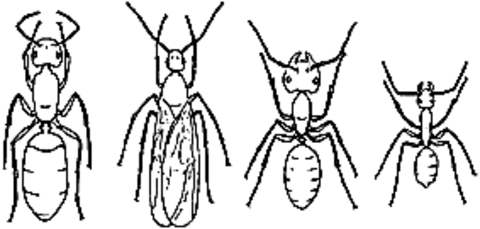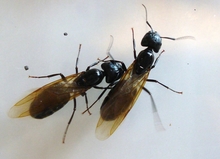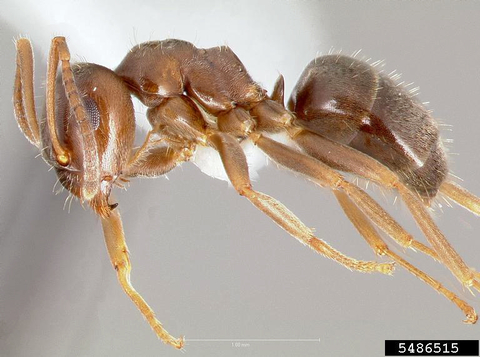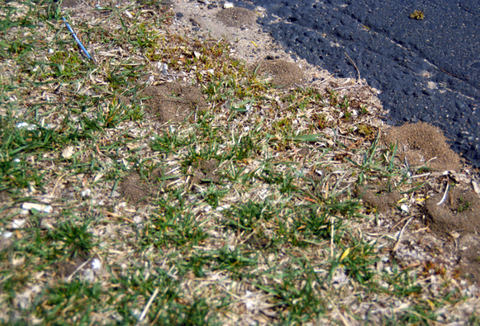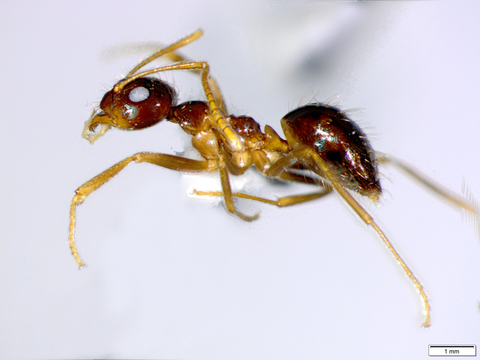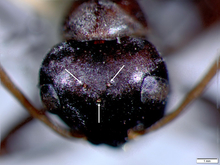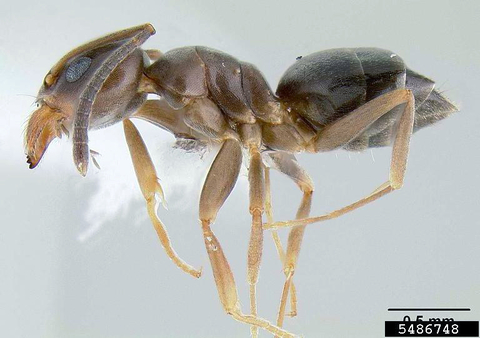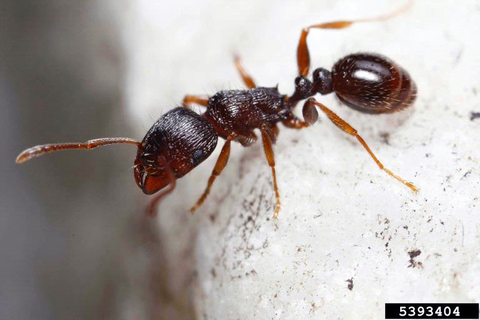Quick facts
- Ants are common pests found in and around homes.
- The first step in control is to identify the ants: knowing the species is necessary to understand where they may be nesting, their food preferences and the best way to treat them.
- The most effective way to get rid of ants is to find and treat the nest.
- Queens must be killed to eliminate a colony.
Identifying ants
Ant identification can be challenging. Correct identification is important as food preferences, nesting sites, and other habits differ. These factors influence the most effective methods for controlling them. If you have an ant you cannot identify, talk to an expert who can.
Important characteristics
Ants are recognized by the following:
- A pair of elbowed (bent) antennae on the head.
- A constricted (pinched) area between the thorax and abdomen called the petiole. The petiole (part of the abdomen) has one or two nodes (bumps).
- Most ants are workers and do not have wings.
- Winged ants (queens and males) may be seen when they swarm.
Most ants are brownish to black. They can also be yellow, reddish, or black and red. Color can be helpful but is not always definitive for identifying ants.
Worker ants vary in size from as small as 1/20 inch long to 1/2 inch long. Size can help narrow down which ant is present but it is usually not enough to identify it without looking at other characteristics.
These characteristics are important to help identify different species of ants, although they may not be easy to see:
- The number of nodes in the petiole and whether they are clearly visible or are hidden.
- The shape of the thorax.
- The presence or absence of spines on the back of the thorax.
- The number of segments in the antennae and whether a club (enlarged segment at the tip) is present.
- The presence or absence of simple eyes (ocelli) on the head.
An ant’s biology can also help identify them, such as where they are nesting and when they swarm (when females and males fly out of their nest).
How to tell an ant from a termite
Ants are sometimes mistaken for winged termites called swarmers.
Ants are different from termites by having a narrow, constricted waist, bent antennae and hind wings shorter than front wings.
Termites have a more rectangular-shaped body with no constrictions; straight, beaded antennae; and four wings of equal size and shape that are much longer than the body. Termite wings fall off easily and are usually found near where they emerge.
Ants are commonly seen in the open, as are winged termites when they swarm. But termite workers, which are creamy-white and wingless, avoid light and are rarely seen unless disturbed.
Biology of ants
Ant castes
Ants live in colonies and are divided into different castes: workers, males and queens. Different castes have different responsibilities in the nest.
Workers are sterile, wingless females. Some ants vary in size and are divided into major (large) and minor (small) workers. The workers take care of the work in the nest, including expanding the nest, food gathering, caring for the eggs and larvae, and defense of the nest
The reproductive members of the colony are the males and queens.
Males are generally the same size or larger than the workers.
- They have wings and a small head with large eyes.
- They are found in older, large colonies.
- Their sole purpose is to mate with the new queens; they die shortly afterward.
Queens are the largest members of the colony, often two to three times larger than workers.
- Queens have wings but break them off after mating.
- They have very large abdomens and can live for a number of years.
- The colonies of some ant species contain just one queen while others have multiple queens.
Mating
- Males and queens swarm (fly) from their nest in large numbers to mate.
- A given species swarms during a specific time of the year.
- After mating, the queens seek sites to begin their own nests.
- The presence of swarming winged ants inside buildings is an indication of an indoor ant nest.
Nesting habits
Ants have a wide variety of nesting habits.
- Some ants build nests in the soil in exposed areas, producing characteristic mounds while others nest in the soil under objects, like logs, bricks, or concrete.
- Some species nest in homes behind moldings, baseboards, countertops, wall voids, and similar places.
- Other ants nest in decaying or moisture-damaged wood.
Food preferences
Different ant species feed on different types of food, including starches, meats, fats, and sweets. Many ants also feed on honeydew, a sweet liquid produced by aphids and scale insects.
Food preferences can change for some species during the season depending on the requirements of the nest.
Damage caused by ants
Damage from ants varies. Most are primarily a nuisance, causing little actual damage, although they can be annoying and even upsetting when found in your home.
Some species can infest food. Others, like carpenter ants, can weaken wood in structures. While not common, at least one species, Pharaoh ant, has been known to transmit some diseases, like Salmonella.
Some ants nest in lawns. Fortunately, they do not feed on or injure grass but their presence can be annoying. Cornfield ants nest in lawns where the grass is thinning or has become bare, creating small mounds. Field ants can nest in areas of the lawn that are growing well, creating mounds up to a foot in size. These large, high mounds can interfere with lawnmowers.
How to control ants
The first step in ant control is to identify them. Knowing which ant is present tells you where they like to nest and what they like to eat. Knowing this helps with the best way to control them.
The most effective way to control ants is to put insecticide into the nest and kill the queen(s). This may be done with a direct treatment or by using bait. Killing foraging workers has little effect as just a small percentage of ants are out of the nest at any given time.
- Sanitation is an important step to avoid attracting ants into a home. Store human and pet foods attractive to ants in insect-proof containers, like glass jars or plastic containers.
- Clean all kitchen surfaces regularly to remove food residue.
- Rinse recyclable containers before storing them.
Other nonchemical steps to discourage ants:
- Use a mild solution of vinegar and water to wipe ant trails to temporarily disrupt ant activity.
- Seal cracks that ants are using to enter the home. Because of their small size, this may not always be practical.
- Use sticky barriers or water moats containing soapy water to prevent ants from reaching plants or other items.
- Prune tree and shrub branches that touch the building to remove an easy route indoors.
- Remove debris that can encourage ant nests. This can include lumber, branches, tree stumps, and thick mulch and leaf litter next to buildings.
It is often challenging to recognize ants from a picture. Because different species may be treated differently, be sure an ant problem is correctly identified before attempting control.
Many ants enter homes from outside nests as they look for food. To find their nest, follow the ants. You can encourage foraging by setting out attractive food.
Ants usually take regular routes to and from their nest by making a chemical (pheromone) trail. The nest may be found by watching where the ants go. For some ants, such as carpenter ants, this works best at night, just after sunset. When the nest is found, it can be treated. In some cases, ants may need to be observed for 30 minutes or longer to locate a nest. Diligent observations can pay off as locating and treating the nest directly is often the most effective way of controlling ants.
Ants can also be a nuisance in lawns because of the mounds they produce, especially if they are abundant. Tolerate ant nests in lawns when possible.
Using insecticides
Outdoor nests can be very difficult to get rid of without applying an insecticide. Be sure to select a product that has directions for treating lawns.
- Granules and dusts are most effective, these products contain active ingredients such as permethrin or deltamethrin.
- Liquid insecticides can work if they are soaked into the nest. You may need 1/2 gallon or more of mixed material to treat large nests. Common examples of active ingredients include bifenthrin, cypermethrin, gamma cyhalothrin, and lambda cyhalothrin.
- Retreatment of nest sites may be necessary if above-ground activity resumes after the initial application.
- If the nest cannot be found, in some cases ants can be kept out of the house by applying an insecticide barrier around the exterior of the building.
If ants are entering only through one area of the house, you can spot-treat that area. If it is not clear where the ants are entering, then treat a 2- to 4-foot wide area around the entire building. This control method is temporary and is not a long term solution.
Insecticides used for treating the exterior of a building may be a liquid or granules. Common examples of available insecticides have active ingredients such as:
- bifenthrin
- cypermethrin
- deltamethrin
- gamma cyhalothrin
These methods are NOT effective to get rid of ants:
- Flooding nests with water
- Pouring gasoline in a nest (it is dangerous and causes environmental pollution)
- Using spearmint gum, red pepper, orange peels, cinnamon, or other herbs
- Lavender and other essential oils
Drenching a nest many times with an insecticidal soap solution is sometimes effective in forcing an ant colony to relocate.
CAUTION: Mention of a pesticide or use of a pesticide label is for educational purposes only. Always follow the pesticide label directions attached to the pesticide container you are using. Be sure that the area you wish to treat is listed on the label of the pesticide you intend to use. Remember, the label is the law.
Ant baits
Using bait is the best way to treat an indoor nest.
- Workers feed on the bait and take it back to the nest where they share it with the rest of the colony.
- Baits are delivered into inaccessible areas that insecticide sprays cannot reach.
- Baits act slowly and may take several weeks to several months to eliminate a colony.
- Ant baits sold in stores for home use are generally labeled for common household ants. Different species of ants will not be equally attracted to all baits.
- Do not spray an insecticide when using a bait; this interferes with the ability of the ants to bring the bait back to the nest.
Although baits can be effective, there are factors that can prevent them from eliminating a nest such as:
- Competing food sources that distract the ants from the bait.
- More than one colony is present.
- Not enough bait is set out.
- The nest’s dietary needs change and they are no longer interested in the bait.
- The bait becomes contaminated with a pesticide or a household chemical and then avoided.
Place baits where foraging workers are active. Common insecticides used in baits have active ingredients like:
- avermectin B1
- dinotefuran
- fipronil
- indoxacarb
- propoxur
- sodium tetraborate decahydrate (Borax)
- spinosad
Spray insecticides
Spraying may be useful for seasonal ant problems when ants enter from outside nests. However, this is only temporary and has little to no impact on the nest.
If possible, observe the ants to locate and directly treat a nest. This is much more effective than spraying the exterior of a structure and uses a much smaller amount of pesticide.
Common spray insecticides used for ant control include cypermethrin, deltamethrin, lambda-cyhalothrin, and permethrin.
Certain types of ants can be more challenging to control than others. If ants continue to be a problem after control efforts have been attempted, consider consulting a pest management professional. Pest management professionals have the training and experience to deal with household ant problems. Contact a pest management company if you want to have your ant problem handled by a professional.
CAUTION: Mention of a pesticide or use of a pesticide label is for educational purposes only. Always follow the pesticide label directions attached to the pesticide container you are using. Be sure that the area you wish to treat is listed on the label of the pesticide you intend to use. Remember, the label is the law.
Identifying ants with one node
Open a drawer for more specific information and photos of each type of ant listed. It is often challenging to recognize ants from a picture. Because different species may be treated differently, be sure an ant problem is correctly identified before attempting control.
Camponotus spp.
How to identify
- Petiole with one node.
- Workers have a thorax with an evenly rounded upper surface.
- Black, or black and red.
- Workers range in size from 3/16 to 1/2 inch; winged queens can be up to 3/4 inch.
- Colonies consist of major and minor workers.
What they eat
- Other insects, both living and dead.
- Meat or other protein sources.
- Sweets, including honeydew, syrup, honey, sugar and jelly.
Carpenter ants DO NOT eat wood; they chew wood into sawdust in the process of creating galleries and tunnels.
Where they nest
- Moist or rotting wood, including trees or tree stumps.
- Behind bathroom tiles, around tubs, sinks, showers and dishwashers.
- Under roofing, in attic beams, and under subfloor insulation.
- In hollow spaces such as doors, curtain rods and wall voids.
- In soft polystyrene and other forms of insulation.
Carpenter ant tunnels are clean and smooth, making the wood appear that it has been sandpapered. In contrast, termite tunnels are not clean looking but are packed with dirt-like material.
Mating swarms
April through June. Occasionally swarms may emerge indoors earlier during late winter on warm, sunny days.
Management
- Apply insecticide directly into the nest.
- Replace damaged or decayed wood.
- Eliminate any moisture problems.
- Baits may also be effective if applied where ant activity is seen.
- Carpenter ant control usually requires the services of a pest management professional.
Read more about Carpenter ants.
Lasius americanus (formerly Lasius alienus)
How to identify
- Petiole with one node
- Thorax is uneven in profile (workers only)
- Relatively large eyes compared to the head
- First antennal segment (also called a scape) is not much longer than the head
- They are light to dark brown
- Workers are about 1/10 – 1/8 inch long
What they eat
- Sweets, including honeydew (they are sometimes found feeding on honeydew from insects infesting houseplants)
- Live and dead insects
Where they nest
Very common in the soil in exposed areas, forming small craters several inches wide, especially in lawns where the grass has thinned or is bare. They can also nest in soil under stones, bricks, sidewalks, and other concealed sites, as well as rotting logs and stumps. They rarely nest in homes.
Mating swarms
July through September, especially on warm, sunny afternoons.
Management
For indoor problems, check for and treat nests in the lawn and other nearby areas. Commercial baits available to the public may be effective.
It is rarely necessary to treat nests in lawns for the sake of the turf. Encouraging grass to grow more fully discourages cornfield ants in lawns.
Prenolepis impairs
How to identify
- Petiole with one node
- Thorax is uneven in profile, looks pinched (workers only)
- First antennal segment (also called a scape) is much longer than the head
- False honey ants are light to dark brown
- Workers are about 1/8 inch long
What they eat
Prefer sweets, especially honeydew.
Where they nest
In soil in open, well-shaded sites. Their nests are rarely concealed under logs, stones, etc. They do not nest indoors.
Mating swarms
April through May.
Management
Tolerate when possible. If ants are persistent, check for ant mounds in open, shaded areas and treat.
Formica spp.
Field ants can easily be confused with carpenter ants due to similar size and coloration, but they are not as likely to forage indoors. They are also confused with fire ants because of the mounds they build; however, fire ants do not occur in the upper Midwest.
How to identify
- Petiole has one node
- Thorax is uneven in profile (workers only)
- Distinct simple eyes (ocelli) on top of their head
- They are black, brown, red, or combinations of these colors
- Workers range in size from about 1/8 to 1/4 inch long
- Colonies consist of major and minor workers
What they eat
Household sweets and honeydew. They also eat live and dead insects.
Where they nest
In soil in exposed areas. Some species make large mounds, up to 10 inches across. They also can nest under objects like wood, stones, and patio blocks. They do not nest inside buildings.
Mating swarms
July through September. Swarms can be very conspicuous outdoors in yards and neighborhoods.
Management
Primarily a problem because of the large mounds they build in lawns. Tolerate when possible. If that is not practical, treat nests with a dust or granules (most effective) or with a liquid.
Field ants indoors are usually a temporary problem and will go away on their own.
Lasius interjectus (formerly Acanthomyops interjectus)
How to identify
- Petiole with one node
- Thorax is uneven in profile (workers only)
- Compound eye is small in proportion to the head
- Give off a pleasant citronella or lemon smell when crushed
- Yellow ants are yellowish to reddish-brown
- Workers are about 3/16 inch long
- Queens are about 5/16 inch long and often reddish and darker
What they eat
Honeydew, rarely other sweets.
Where they nest
In soil under stones, logs, bricks, patio blocks, concrete and other concealed areas. They also can nest in rotting wood. Yellow ants can nest in and around foundation walls and in soil under buildings on slab construction. Workers are rarely seen but may be found throwing out dirt or cement particles; they do not damage masonry or wood.
Mating swarms
April through September. Swarms are also common indoors during winter if ants are nesting under heated concrete slabs.
Management
Eliminate winged yellow ants with a vacuum or by hand. Large numbers can be treated with an aerosol insecticide labeled for flying insects, such as pyrethrins. Detection of yellow ants nesting under concrete slabs is difficult and control is not practical or needed.
Tapinoma sessile
How to identify
- Petiole with one node but it is hidden by the abdomen and is hard to see
- Thorax is uneven in profile (workers only)
- Gives off an unpleasant smell when crushed; some people compare it to rotten coconuts or blue cheese
- Odorous house ants are brown to dark brown
- Workers are about 1/10 inch long
What they eat
Sweets, especially honeydew, and live insects. Can forage indoors for sweets and other foods, including meats.
Where they nest
In soil under stones, boards, patio blocks, mulching plastic, and nearly any other object laying on the ground. They can nest in homes in walls voids and under floors, especially with nearby sources of moisture.
Mating swarms
June through July
Management
Check for outdoor nests, especially under stones, firewood, bricks, and other objects; treat any that are found. Also treat any honeydew-producing insects, like aphids that are nearby serving as a food source.
The use of baits can be effective. Persistent odorous house ant problems should be treated by a pest management professional.
Identifying ants with two nodes
Crematogaster spp.
Acrobat ants get their name from their habit of holding their abdomen over their thorax, especially when they have been disturbed.
How to identify
- Petiole with two nodes
- A pair of large spines present on the back of the thorax
- Abdomen is heart-shaped
- Petiole attaches to the top of the abdomen
- Yellow-brown to black
- Workers are about 1/8 inch long
What they eat
A wide variety of food, including sweets, meats, and insects.
Where they nest
Dead or rotted wood, including logs, stumps, dead tree branches. They occasionally nest in soil under stones.
Indoors they nest in wall voids and rotted wood, especially window frames. They do not cause structural damage to buildings.
Mating swarms
July through September
Management
Check for nests in rotted wood. Remove and destroy infested wood when possible. Nests can also be treated with an appropriate insecticide (do not treat if a nest is found in firewood).
For acrobat ants found indoors in voids, consider hiring a pest control professional to apply insecticidal dust into the wall void. When possible, replace rotted wood and correct moisture problems.
Tetramorium immigrans (formerly Tetramorium caespitum)
How to identify
- Petiole with two nodes
- About 1/8 inch long
- A pair of small spines on the back of the thorax
- Head and thorax covered in fine grooves when viewed under magnification
- Reddish-brown to black
- Workers are about 1/8 inch long
What they eat
Variety of foods including meats, pet food, sweets, bread, nuts, and insects.
Where they nest
In soil under sidewalks, driveways, stones, logs and other concealed sites. Also commonly found under homes with concrete slab construction; ants enter homes through cracks in the concrete. They can also sometimes be found indoors in wall voids
Mating swarms
May through July. When the nest is under a heated slab foundation, swarms can also occur indoors during winter.
Management
Look for and treat outdoor nests. If you can't find an outdoor nest, treating the building perimeter with a residual spray can provide temporary control. When pavement ants are nesting under heated concrete slabs, baiting is the most effective control tactic.
Monomorium pharaonis
Pharaoh ants are an imported species, probably from the tropical regions of Africa. They have readily spread through the world along commerce routes.
How to identify
- Petiole has two nodes
- Thorax lacks spines
- Antennae with 12 segments
- Antennal club composed of 3 segments
- Normal sized compound eye in proportion to head
- Light yellow to red with a darker colored thorax
- Very small ants—workers are about 1/16 inch long
- Due to their small size, pharaoh ants can easily be confused with thief ants. A microscope is often needed to separate the two species.
What they eat
They feed on a wide variety of foods, especially those containing grease or fats. They also feed on many types of sweets, dead insects, toothpaste, soap and other foods that other ants rarely attack.
They often seek out water in kitchens and bathrooms.
Where they nest
Pharaoh ants nest strictly indoors in the north central states. They do not survive outdoors. They nest in a wide variety of small spaces, cracks and crevices, including behind countertops, baseboards, in wall voids, and many other small voids. They often nest near dark, warm sites and near sources of moisture. Pharaoh ant nests are very difficult to find.
Mating swarms
Pharaoh ants do not have a mating swarm but produce new nests through a process called budding. When the colony becomes too large or is under stress, a group of workers take brood (i.e. larvae and pupae) and move to a new site. One or more queens often go with them to the new nest.
Management
Elimination of Pharaoh ants is difficult, and the service of an experienced pest management service is highly recommended. Insecticides can cause Pharaoh ants to bud, creating new colonies.
The use of baits is the best control, although the baits available to residents are generally not effective. Pest management professionals have the experience and access to effective baits needed to successfully eliminate Pharaoh ants.
Solenopsis molesta
Also referred to as grease ants, thief ants are the smallest household ants in the north central states. Thief ants nest near the nests of larger ants and steal their larvae. They often have well-defined trails.
How to identify
- Have petiole with two nodes
- Thorax lacks spines
- Antennae with 10 segments
- Antennal club with 2 segments
- Compound eyes small in proportion to their head
- They tend to curl up when dead
- Thief ants are easily confused with Pharaoh ants
- Thief ants are yellow to light brown
- Workers measure about 1/20 inch long
What they eat
They prefer protein and greasy foods, such as meats, cheese, peanut butter and nuts, but will also eat sweets. They are small enough to enter almost any type of food container.
Where they nest
Thief ants commonly nest in soil and rotting wood. They can nest indoors in small spaces, under countertops, in wall voids, cabinet voids, behind baseboards. Nests are often difficult to find.
Mating swarms
July through September.
Management
Thief ants are especially common during mid to late summer when they enter homes from outside nests. Locating and treating nests is not practical.
Treat the building perimeter when thief ants are foraging into buildings from outside nests. If ignored, they will eventually go away on their own.
When nests are located indoors, baiting is the most effective management method.
Reviewed in 2024





